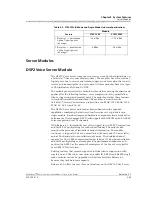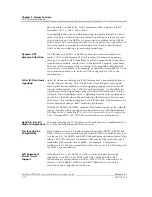
255-700-019
3-75
PacketStar
™
PSAX 20 Access Concentrator User Guide
, Issue 1
Release 6.3.0
Chapter 3 System Features
Route Server Module
relay, bridge, routing, or asynchronous transfer mode (ATM). All traffic on
the Route Server module runs through IP in compliance with media access
control (MAC) encapsulation:
•
IP over ATM (RFC 1483)
•
IP over frame relay (RFC 1490)
•
IP over Ethernet
The module can be configured through either the Access Concentrator
system console or through simple network management protocol (SNMP).
Each Access Concentrator system may support multiple Route Server
modules, but multiple Route Server modules cannot be configured for hot
standby redundancy purposes.
Software Release 6.3.0 introduces routing information protocol (RIP) Version
2 to the Route Server module. The module now supports Internet Protocol
virtual private networks (VPNs) by assigning multiple IP network interfaces
and static routes. (The Route Server module also supports RIP v1.0, and can
interact with any other Access Concentrator module port that is configured
for frame relay, Ethernet bridging, or ATM.)
Release 6.3.0 software, supporting RIP v2.0, allows you to divide networks to
a further extent than the traditional subnet classes (Class A, B, and C)
available with RIP v1.0. RIP v2.0 enables authentication and multicasting,
and allows you to run different masks on different subnets. Rip v2.0 can be
either active or passive.
You can assign an authentication password to an IP network interface for
maximum security. Doing so can prevent those who cannot directly access
the network from sending false routing information to the routers. RIP v1.0
messages will be ignored when authentication is in use. However,
authentication does not prevent RIP v1.0 routers from viewing RIP v2.0
messages. To prevent RIP v1.0 routers from viewing RIP v2.0 messages, you
must use multicasting.
Multicasting reduces load on hosts not using RIP v2.0 messages. Multicasting
also allows RIP v2.0 routers to share information that RIP v1.0 routers
cannot access. Available bandwidth becomes the tiebreaker in calculating
routes using default parameters for both IISP and PNNI routing.
Software Features
The software supports the following Frame Relay Forum (FRF)
Implementation Agreements:
~
FRF.5—Frame Relay/ATM PVC Network Interworking
~
FRF.8—Frame Relay/ATM PVC Service Interworking
•
Interfaces: IP over ATM (IETF RFC 1483), IP over frame relay (IETF RFC
1490), IP over Ethernet (bridge)
•
Multi-service routing:
~
ICMP (RFC 792)
~
Static routing with six independent VPNs
~
IP routing
Summary of Contents for PacketStar PSAX 20
Page 399: ......
















































